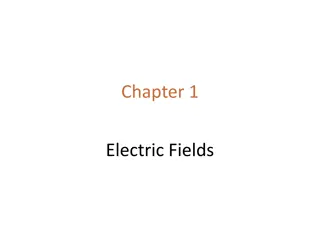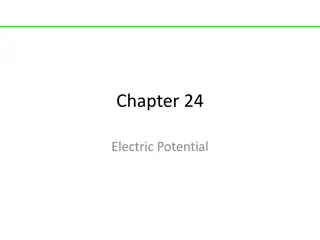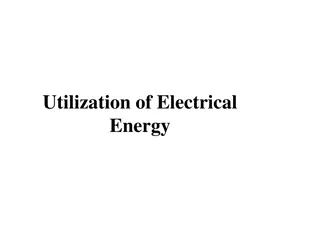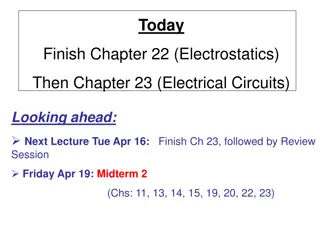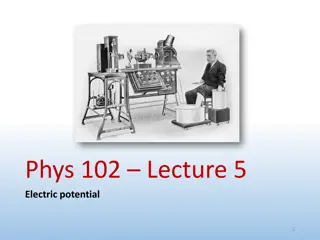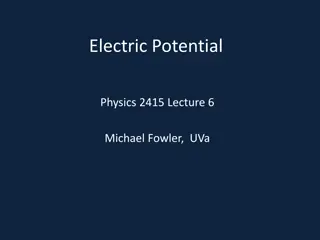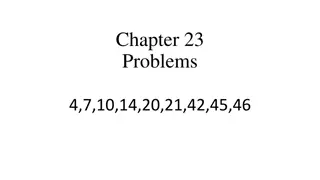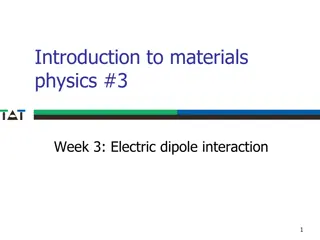Understanding Electric Potential and Energy in Physics
Electric potential and energy play essential roles in physics, influencing the behavior and interactions of charged particles in electric fields. This content explores concepts like electric potential, gravitational potential energy, electric potential energy of point charges, and the work involved in changing energy levels of point charges. Through illustrative examples and explanations, you can grasp the significance of these concepts in understanding the dynamics of electric fields and charged particles.
Download Presentation

Please find below an Image/Link to download the presentation.
The content on the website is provided AS IS for your information and personal use only. It may not be sold, licensed, or shared on other websites without obtaining consent from the author. Download presentation by click this link. If you encounter any issues during the download, it is possible that the publisher has removed the file from their server.
E N D
Presentation Transcript
Gravitational Potential Energy A GPE = mg h GPE = mghA mghB F = mg GPE = Work (W) required to raise or lower the book. -Where W = (Fgravity)( h) B hA hB
Electric Potential Energy (EPE) + + + + + + + + + ??(??)= ? ? ? ??(??)= ? ?? ? ? ?? A + ? Since the electric field is uniform between the two plates, the force acting on the proton will be the same everywhere. And since work = energy ??? = ? Fe = qoE dA B + ??? ? ? ??? dB Fe = qoE ? ??? = ? ?? ? - - - - - - - - - - Does a proton at rest at point A have more or less potential energy than it would at point B? More
Electric Potential Energy of Point Charges Much like the book is attracted to the earth due to gravity, two unlike charges are attracted to one another. Conversely, like charges repel. It takes positive work to move unlike charges away from one another and negative work to move them closer together. -qo kqq kqq = e= o e= o EPE F r F E r 2 r r +q
Electric Potential Energy and Work of Point Charges -qo To change the energy level from EPEA to EPEB, it requires positive work (W). rB -qo = W EPE EPE rA B A kqq kqq = +q o o +q W r r B A B A
Electric Potential Energy 1. What would happen if the charged particle q was fixed in place and then particle qo was suddenly released from rest? It would accelerate away from q. It would accelerate towards q. It would stay where it is. A. -qo B. C. 2. How would the potential energy of this system change? It would increase. It would decrease. It would remain the same. +q A. B. C.
Electric Potential EPE W = = = V V V B A q q o o kqq = Since o EPE r Point Charges only kq kq = V r r B A SI Units: joule/coulomb = 1 volt (V) The Electric Potential Difference is equal to the Work required to move a test charge from infinity to a point in an electric field divided by the magnitude of the test charge. The Electric Potential is the energy per unit of charge (J/C).
Example 1: Electric Potential An object with 2.5 C of charge requires 1.00x10-3 Joules of energy to move it through an electric field. What is the potential difference through which the charge is moved? . 0 001 W J = = V 6 q 5 . 2 10 C = 400 / V J C = 400 V V
Relationship Between Electric Potential and Distance(point charges) Consider relationship between V and r. -WAB kq qo rB kq rA VB - VA = = - What happens to V as rB goes to ? As r increases, i.e., as rB , V 0. The relationship above reduces to: V = kq/r The sign of the charge will determine if the electric potential is positive or negative. When two or more charges are present, the total electric potential is the sum total from all the charges present in the system.
Electric Potential(point charges) Consider the following system of three point charges. What is the electric potential that these charges give rise to at some arbitrary point P? Use superposition to determine V. kQ1 kQ2 kQ3 r1 r2 r3 Q1 V = + + Q2 Note that the electric potential can be determined from any arbitrary point in space. r1 r2 Q3 r3 P
Electric Potential and Electrical Potential Energy/Work (point charges) If we now move a test charge from infinity to point P, we can determine the potential energy of the system or the work required to the test charge to its new location. EPE W q V = = = + + Q1 o Q2 Q r Q r Q r 3 1 2 W kq r1 r2 o Q3 1 2 3 r3 Remember: work = energy. qo
Example 2: Two Point Charges Two point charges, +3.00 C and -6.10 C, are separated by 1.00 m. What is the electric potential midway between them? -6.10 C +3.00 C B A 0.5 m 0.5 m Vtotal = VA + VB = kqA/rA + kqB/rB VA = (8.99 x 109 Nm2/C2)(-6.10 x 10-6C) = -109678 V 0.5m VB = (8.99 x 109 Nm2/C2)(3.00 x 10-6C) = 53,940 V 0.5m Vtotal = -55700 V
Characteristics of a Capacitor + + + + + + + + + + + + + + + - - - - - - - - - - - - - - - Uniform Electric Field Two equal and oppositely charged plates qo B E qo C qo A Since the electric field is constant, the force acting on a charged particle will be the same everywhere between the plates. Fe = qoE FA = FB = FC
Electric Potential and Work in a Capacitor + + + + + + + + + + + + + + + - - - - - - - - - - - - - - - D WAB = F dB - F dA A B WAB = qoE d qo qo F = qoE F = qoE dB (EPE) -WAB qo V = = dA qo C qo If WAB = qoE d, then what is WCD? WCD = 0 Joules because the force acts perpendicular to the direction of motion. Do you remember that W = F d cos ?
Electric Potential of a Capacitor An alternative From mechanics, W = Fd. From the previous slide, W = qoEd From the reference table, V = W/qo W = AB + + + + + + + + + + + + + + + V - - - - - - - - - - - - - - - Two equal and oppositely charged plates q o A B Fd qo = q F = qoE o Uniform Electric Field d q Ed = o q o = V Ed
Example 3:Parallel Plates A spark plug in an automobile engine consists of two metal conductors that are separated by a distance of 0.50 mm. When an electric spark jumps between them, the magnitude of the electric field is 4.8 x 107 V/m. What is the magnitude of the potential difference V between the conductors? V = Ed V = (4.8 x 107 V/m)(5.0 x 10-4m) V = 24,000V d
Example 4: Parallel Plates A proton and an electron are released from rest from a similarly charged plate of a capacitor. The electric potential is 100,000 V and the distance between the two plates is 0.10 mm. 1. Which charge will have greater kinetic energy at the moment it reaches the opposite plate? 2. Determine the amount of work done on each particle. 3. Determine the speed of each particle at the moment it reaches the opposite plate. 4. Determine the magnitude of the force acting on each particle. 5. Determine the magnitude of the acceleration of each particle.
Example 4: Parallel Plates(cont.) + + + + + + + + + + + + + + + - - - - - - - - - - - - - - - p+ e- d Begin by drawing a picture and listing what is known: V = 100,000V d = 0.10 mm = 1.0 x 10-4m qe = qp = 1.6 x 10-19C (ignore the sign. We are only interested in magnitude.)
Example 4: Parallel Plates(#1 & #2) For #1, you could answer #2 first to verify. The answer is that the kinetic energy of both particles will be the same Why? because of the formula needed in question #2 applies to both charges, and work = energy. Hence: Wproton = Welectron qprotonV = qelectronV Wproton = Welectron = (1.6x10-19C)(100,000V) Wproton = Welectron = 1.6x10-14 J
Example 4: Parallel Plates(#3) Apply the work-energy theorem to determine the final speed of the electron and proton. W = KE Since the initial kinetic energy is equal to 0J: W = KEf W = mvf2 14 (2)( ( m ) (2)(1.6 10 (1.67 10 ) ) W J = = = Proton: 6 4.38 10 / v m s f 27 ) kg proton 14 (2)( ( m ) (2)(1.6 10 (9.11 10 ) W J Electron: = = = 8 1.87 10 / v m s f 31 ) ) kg electron
Example 4: Parallel Plates(#4) Since F = qE, it will be the same for both particles because their charges are the same and the electric field is uniform between two parallel plates. We also know that W = F d. Since we know the distance between the plates and the work done to move either charge from one plate to another, we can determine the force as follows: = = 14 1.6 10 1.0 10 W d J = 1.6 10 10 F N 4 m
Example 4: Parallel Plates(#5) Since we have the force acting on each particle, we can now calculate the acceleration of each particle using Newton s 2nd Law. 10 1.6 10 1.67 10 F N kg = = = 9.6 10 16 2 / a m s 27 m proton F 10 1.6 10 9.11 10 N kg = = = 1.8 10 20 2 / a m s 31 electron m
Equipotential Lines Equipotential lines denote where the electric potential is the same in an electric field. The potential is the same anywhere on an equipotential surface a distance r from a point charge, or d from a plate. No work is done to move a charge along an equipotential surface. Hence VB = VA (The electric potential difference does not depend on the path taken from A to B). Electric field lines and equipotential lines cross at right angles and point in the direction of decreasing potential.
Equipotential Lines Parallel Plate Capacitor Lines of Equipotential + + + + + + + + + + + + + + + - - - - - - - - - - - - - - - Electric Field Lines Note: Electric field lines and lines of equipotential intersect at right angles. Decreasing Electric Potential / Voltage
Equipotential Lines Point Charge Note: Electric field lines and lines of equipotential intersect at right angles. Lines of Equipotential + Electric Field Lines Note: A charged surface is also an equipotential surface! Decreasing Electric Potential / Voltage
Equipotential Lines (Examples) http://www.cco.caltech.edu/~phys1/java/phys1/ EField/EField.html
Key Ideas Electric potential energy (U) is the work required to bring a positive unit charge from infinity to a point in an electric field. Electric potential (V) is the change in energy per unit charge as the charge is brought from one point to another. The electric field between two charged plates is constant meaning that the force is constant between them as well. The electric potential between two points is not dependent on the path taken to get there. Electric field lines and lines of equipotential intersect at right angles.
Electric Potential Energy and Work in a Uniform Electric Field + + + + + + + + + + + + + + + - - - - - - - - - - - - - - - A B qo qo F = qoE F = qoE Note: The force acting on the charge is constant as it moves from one plate to another because the electric field is uniform. dB dA WAB = EPEB EPEA WAB = FdB FdA WAB = qoEdB qoEdA WAB = qoE(dB dA) = qoE d



